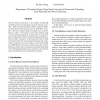ACSAC
1998
IEEE
14 years 3 months ago
1998
IEEE
Network-based attacks have become common and sophisticated. For this reason, intrusion detection systems are now shifting their focus from the hosts and their operating systems to...
SP
1999
IEEE
14 years 3 months ago
1999
IEEE
There is often the need to update an installed Intrusion Detection System (IDS) due to new attack methods or upgraded computing environments. Since many current IDSs are construct...
SP
1999
IEEE
14 years 3 months ago
1999
IEEE
This paper describes an expert system development toolset called the Production-Based Expert System Toolset (P-BEST) and how it is employed in the development of a modern generic ...
MOBICOM
2000
ACM
14 years 3 months ago
2000
ACM
As the recent denial-of-service attacks on several major Internet sites have shown us, no open computer network is immune from intrusions. The wireless ad-hoc network is particula...
NDSS
2000
IEEE
14 years 3 months ago
2000
IEEE
Traditional Intrusion Detection Systems (IDSs) mostly work off-line, without any direct runtime interaction or coordination with the applications (and with other IDSs) that they a...
IJCNN
2000
IEEE
14 years 3 months ago
2000
IEEE
The timely and accurate detection of computer and network system intrusions has always been an elusive goal for system administrators and information security researchers. Existin...
ACSAC
2000
IEEE
14 years 4 months ago
2000
IEEE
Cooperative frameworks for intrusion detection and response exemplify a key area of today’s computer research: automating defenses against malicious attacks that increasingly ar...
ADHOCNETS
2009
Springer
14 years 4 months ago
2009
Springer
Mobile ad hoc networks (MANETs) are a highly promising new form of networking. However they are more vulnerable to attacks than wired networks. In addition, conventional intrusion ...
HAIS
2010
Springer
14 years 4 months ago
2010
Springer
Abstract. Accurate and swift responses are crucial to Intrusion Detection Systems (IDSs), especially if automatic abortion mechanisms are running. In keeping with this idea, this w...
ICPR
2002
IEEE
14 years 4 months ago
2002
IEEE
Network intrusion detection is the problem of detecting anomalous network connections caused by intrusive activities. Many intrusion detection systems proposed before use both nor...



